Abstract
Land degradation through erosion processes is probably the most restrictive issue regarding the sustainable agricultural use of land resources in contemporary Romania. The socio-economic changes that occurred in Romanian society after 1990 resulted in a sharp decline in the implementation of conservation practices along with an increase in intensity of land degradation. Consequently, the present paper firstly aims to analyse the actual spread and intensity of land degradation in the Puriceni-Bahnari catchment, representative area in terms soil erosion within Moldavian Plateau of Eastern Romania. Secondly, the achievement of a dedicated project at the level of the entire basin regarding the implementation of land conservation practices is the most suitable solution for the sustainable agricultural use of this fragile natural resource. The results prove the severe degradation state of the agricultural land, with a mean value of annual soil loss of 15.46 t·ha−1·yr−1 (13,500 t·yr−1). Furthermore, 460 ha of agricultural lands (72.7% of total) falls within the category that exceeds the limit of admissible erosion of 7 t·ha−1·yr−1. As a solution to the existing land use pattern, we designed a map of proposed conservation measures and works on agricultural land for the whole catchment that can be relatively easily implemented and conserve soil and water. The main issues of the proposed land use pattern are: (1) the entire cropland must be reduced and changed to a strip-cropping system; (2) the quality of the pastures should be improved; (3) the forested area must be substantially extended, especially on account of unproductive land, and (4) the agricultural road network must be halved and entirely reshaped. In conclusion, the large-scale implementation of conservation practices on degraded agricultural land is the only rational solution for sustainable development of poor local communities in the hilly areas from eastern Romania.
1. Introduction
Agricultural land planning represents a set of technical, economical, juridical and social measures that aimed both to rationally use and preserve the land resources [1]. By continuously trying to harmonize the natural offer of land resources with the socio-economic needs of the society, this activity became an essential component of the concept of sustainable development.
Worldwide, land degradation through soil erosion enhanced by anthropogenic activity is spreading extremely fast, especially in more fragile geographical environments [2]. In the long term, the depletion of soil resources by erosion may be the most serious threat to humanity [3] due the on-site and off-site impact and its mitigation on the ecosystem and socio-economic services [4]. Usually, the main effect of the erosion on soil is directly related to the modification of its properties, which subsequently leads to the reduction of fertility and, finally, the decrease in agricultural production [5].
In this context, the implementation of land conservation measures is recognized worldwide as a very important activity that contributes to an increase in the level of the agricultural production and to overall improve the quality of the environment [6]. Consequently, numerous recent research studies have tried to evaluate the extent and intensity of erosion [7,8], to substantiate either the need to implement these measures [9,10,11] or to assess how effective are these techniques in reducing runoff and soil and water losses in different environments all over the world [12,13,14,15,16]. Many of these papers use modern GIS-based techniques [17,18].
In Romania, land degradation is recognized as the major cause of environmental degradation especially in the agricultural hilly areas of the Moldavian Plateau (MP). This area is highly susceptible to soil erosion [19], gullying [20] and landslides to a lesser degree [21].
On the agricultural lands in Romania, the first soil and water conservation works were successfully implemented on a large-scale starting with the second half of the 20th century. The widespread application of this policy at the national level was the main goal of the ‘Perieni-Barlad Research Station for Soil Erosion Control’ (C.C.D.C.E.S. Perieni), which was established in 1954. It became the ‘Central Research Station’ in 1970 and served as a model for soil and water conservation throughout Romania [22]. The main findings of the field experiments conducted by specialists in the C.C.D.C.E.S. Perieni falls into complex research topics grouped in two directions, namely: (1) assessment of land degradation processes [23,24,25,26] and (2) implementation of soil and water conservation practices [27,28,29]. All these substantiate the urgent need for widespread adoption of complex technical and agrotechnical measures and works that promote sustainable agriculture.
During the communist period, which lasted from 1947 to 1989, private property was replaced by common property in the form of Agricultural Production Cooperatives (CAPs). This joint exploitation of agricultural lands, doubled by a state policy imposed by force, allowed the implementation of such soil conservation measures.
Unfortunately, after 1990, as a result of the socio-economic changes that occurred in Romania, the agricultural lands returned to the old owner. The new Agricultural Real Estate Act implemented since 1991 included a series of provisions that led to the excessive land division higher than before World War II according to the number of current heirs. Moreover, the law restored the traditional agricultural system of ‘up-and-down slope’ farming. Above all, the State ceased funding soil conservation and investment in soil conservation among landowners. All these favoured an increase in the intensity of agricultural land degradation due to erosion at the same time as a decrease in the pace of implementation of specific soil conservation works [19].
Under this background, the present paper firstly aims to assess the state of degradation by erosion on agricultural lands in the Puriceni-Bahnari catchment, a representative area in terms of land degradation within MP. Secondly, by means of a proposed project to implement conservation practices, the most suitable practical solutions on durable use of degraded agricultural land are proposed.
2. Study Area
Extending over ~27,000 km2, the MP is the broadest and most typical plateau in Romania. Generally, it appears as an aggregate of platforms, hills and rolling hills (collines) whose surface altitudes decrease towards the south-southeast [30].
The major units of the MP are the Suceava Plateau (SP), the Jijia Rolling Plain (JRP) in the northern part, and the Barlad Plateau (BP) and Covurlui High Plain (CHP) in the central–southern area. The BP is the most extensive elevated area of the MP and covers >8000 km2 [31].
As part of the Chioara-Ghermanesti catchment, the Puriceni-Bahnari brook watershed is in the south of the Barlad Plateau, and it covers 874 ha (Figure 1).
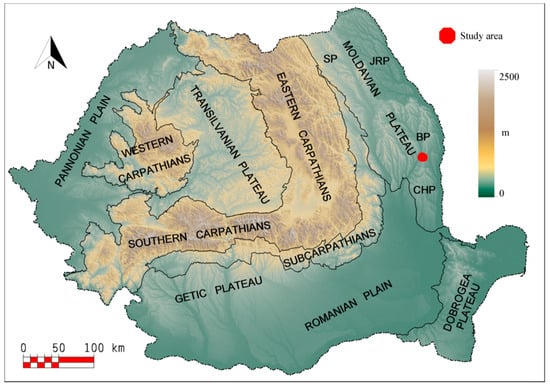
Figure 1.
Location of the study area.
From a geological point of view, the oldest sedimentary deposits that occur in the area are the Chersonian deposits, followed by the Meotian deposits that were formed by a succession of sands, sand–clays, and clays with thin intercalations of sandstones [32]. The most recent Quaternary deposits were put into place after the installation of the hydrographic network and are represented by terrace and loessoid deposits; namely, yellowish siltites that generally appear on the interfluvial ridges.
Against the background of a sandy–clay substrate arranged in a monoclinal structure (where the general slope of the layers ranges from 7 to 8 m·km−1 in the NNV-SSE direction), the hydrographic network deepened continuously, which led to the formation of a cuesta landform that is typical of the entire MP. Therefore, within the studied area, there are three main landform types, namely, the structural-lithological landforms, sculptural landforms, and fluvial landforms.
From an altitudinal point of view, the lowest values (<100 m) are found on the floodplains in the main valleys. The maximum altitude reaches almost 300 m in Tafu Hill (289 m), which is located at the eastern ridge of the Chioara-Ghermanesti catchment (Figure 2).
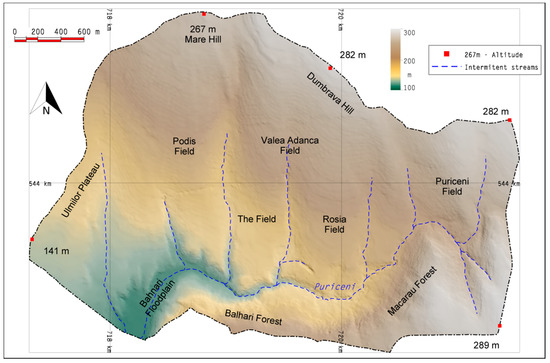
Figure 2.
Hipsometric map in the Puriceni-Bahnari catchment (according to the Topographic Plans, scale 1:5000, 1974–1978 edition).
With general deepening, the relief evolved by associating the slope processes (e.g., surface and gully erosion and landslides) with the processes of lateral erosion and sedimentation on the floodplains.
On the surface of the studied catchment, a whole range of slope values can be observed (Figure 3). They range from very small slopes (0–1%) to very large ones (>35%). The approximately flat surfaces (0–1%) generally overlap the interfluve plateaus, while the average values (5–15%) characterize most of the slopes that are generally affected by soil erosion processes. High slopes, with values ranging from 15% to 35%, appear mainly on the cuesta fronts of the northern general exposure that accompany the main valleys. Due to the development of intense erosion and with a dominant use of degraded pasture, these areas are not suitable for agricultural activities. Notably, slopes of more than 35% may appear both on cuesta fronts and cuesta backslope where torrential catchments or small valleys have formed, such as on the southern slope of the Bahnari valley or on the northern front of the Petrisoara valley.
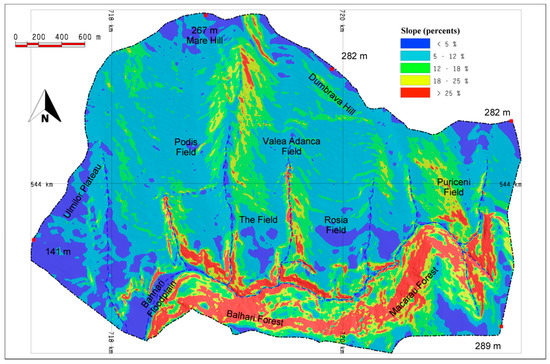
Figure 3.
Slope map in the Puriceni-Bahnari catchment (according to the Topographic Plans, scale 1:5000, 1974–1978 edition).
From a climatic point of view, the dominant note is the hemiboreal temperate climate, according to Köppen classification [33], with excessive shade that is characterized by dry and cold winters and dry and hot summers [34].
According to the data recorded at the Barlad Meteorological Station [35], the average annual temperature increased from 9 to 9.8 °C. In addition, the annual rainfall reached a mean value of 508.8 mm during 1961–2019. The annual distribution of rainfall shows a clear difference between the summer months (July—71.2 mm·yr−1) that have twice the value compared to the autumn–winter months (October–November—30.5 mm·yr−1). Usually, from April to September, 60–65% of the total rain falls, while in the autumn-winter months, only 35–40% falls, a good part of it being in the form of snow.
The hydrographic network is represented by the Chioara river and its right tributary Puriceni-Bahnari. The supply sources come mainly from rain and snow (70–90% of the total) and less comes from groundwater. The river runoff regime belongs to the area with the smallest runoff in the country that has a specific mean liquid runoff of 1 l·sec−1·km−2 [36]. This is why the drying up of watercourses, especially during hot periods, is a common phenomenon.
In addition, a common phenomenon is the appearance of exceptional floods with a special erosive effect. An eloquent example that illustrates this phenomenon very well is the one in the Valcioaia and Tumba valleys during the thaw from 19 to 23 March 1993 [24]. These catchments are located right next to our case study area, with a similar natural pattern. The field measurements showed that when the total precipitation was only 54.0 mm, the maximum liquid flows were 5.01 m3·sec−1 on 20 March 1993, and 4.02 m3·sec−1 on 21 March 1993. The turbidity on 20 March 1993, and 21 March 1993, had high maximum values of 312 g·L−1 and 279 g·L−1, respectively.
The natural vegetation is located in the forest-steppe area with patches of forest containing thermophilic essences [36]. On the natural meadows, there are associations of Lessing feather grass (Stipa lessingiana), Volga fescue (Festuca valesiaca), and wheatgrass (Agropirum cristatum). On the intensely degraded meadows, which appear mainly on the cuesta backslope due to overgrazing, secondary vegetation was installed with associations of bulbous meadow-grass (Poa bulbosa), yellow bluestem (Botriochloa ischaemum), and drooping brome (Bromus tectorum).
Under natural conditions, the characteristic soil types are represented by Chernozem and Phaeozems, both belonging to the Cernisols class [37]. They occur on gentle slopes, generally under 180–200 m in altitude. The upper part of the slopes and interfluvial ridges are covered with Entyc and Tipic Luvosol, belonging to the Luvisols class. Locally, under steep slopes located in the southern part of the catchment, Regosols typify the lands.
Currently, according to the current land use map in the Puriceni-Bahnari catchment, out of a total of 874.34 ha, over 56% is used as arable land (Figure 4, Table 1). Pastures occupy almost 15%—the vast majority of which are severely degraded. The vineyards comprise only 13.5 ha, representing only 1.55% of the total. Many of these forest plantations were established before 1989 and cover large areas that are excessively eroded either by gullies or by soil erosion. A special situation is represented by the exploitation (agricultural) roads that, due to the accentuated fragmentation of the land plots, have a rather important surface of over 17.64 ha (2.02%). Unproductive land does not exceed 11.81 ha, representing 1.35% of the total area.

Figure 4.
Current land use map in the Puriceni-Bahnari catchment (based on aerial photos, 0.5 × 0.5 m, 2012).

Table 1.
The current land use in the Puriceni-Bahnari catchment.
There are no settlements within the researched area, but the agricultural lands are administrated exclusively by small family farms belonging to Banca Commune within the Vaslui County. According to the Territorial Observatory published by the Ministry of Regional Development and Public Administration [38], the total population of the commune continuously decreased from 5943 inhabitants (1991) to 5449 (2020). In the last 30 years, no fewer than 1756 people, mostly young active labour force, emigrated abroad due to the precarious socio-economic situation.
From almost 3200 active people, only 761 are registered as employees (23%)—most of them being budgetary staff (e.g., local administration, teachers etc.). In fact, the functional typology of the locality is of the predominant Primary type with over 82% of active people working in the Primary sector, especially agriculture.
From an economic point of view, the entire region belongs to the agricultural sector with incipient vine fruit specialization, in which cereals with technical plants dominate [39]. The most common crop plants are corn on 66% of cultivated area, winter wheat (15%), sunflower (15%) and fewer soybeans. Consequently, the area is distinguished by a high percentage of agricultural land on account of a shrinking forest percentage, based on a heterogeneous soil cover consisting both of fertile forest-steppe soils (Chernozem, Phaeozems) and poor forest soils (Entyc and Tipic Luvosol) [38].
This socio-economic pattern typifies the entire rural area in the eastern part of Romania during the post-communist period, especially after 2007 when Romania joined EU. In this way, the precarious economic situation was maintained further, and the whole region remains as one of the poorest in the EU.
Over the last two hundred years, the destructive farming practices has prevailed, resulting in a high pressure on the landforms, soils and the vegetal cover [6]. Following the intense deforestation processes of the last two centuries and the expansion of agricultural areas, the erosion processes have manifested themselves more intensely on much larger areas [40] (Figure 5).
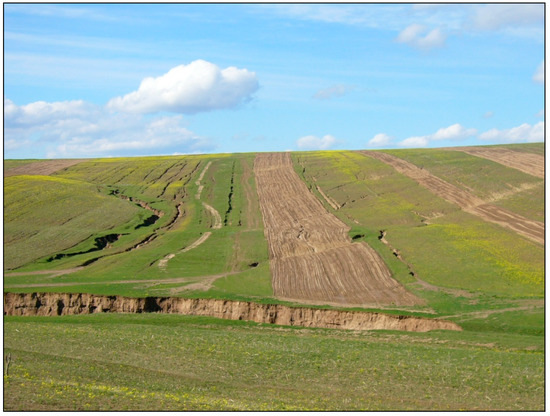
Figure 5.
Intense land degradation by soil and gully erosion on the right side of Valcioaia Valley. (10 May 2005).
This is mainly due to the inadequate exploitation of the agricultural land, namely, by the excessive fragmentation of the land into up-and-down slope farming and arrangement of roads on the highest slope line, for example. All have the effect of intensifying land degradation by soil erosion, gully erosion, and sedimentation of alluvial plains resulting in the removal of large areas of land from the agricultural circuit.
Through the end of the 1980s, a series of conservation efforts for agricultural land was carried out within the Chioara-Ghermanesti catchment, with a special emphasis on soil erosion control measures. Currently, there are some areas with terraces carried out on moderately and excessively degraded cuesta fronts, and there is a majority of forest plantations (Robinia pseudoaccacia).
3. Methods
This paper is the result of combining office with field work. In the first phase, the main physical-geographical characteristics of the studied area were documented.
Thus, for the entire area, a series of thematic maps were made, aiming at the landform pattern and the soil cover, for example. All the maps were made at a resolution of 0.5 × 0.5 m. The support consisted of a digital elevation model (DEM), which was made in accordance with the topographic maps (1974, 1977, 1981, and 1983) at a scale of 1: 5000 in Stereo 70 projection [41]. Starting from this, a series of morphometric maps were made, such as a hypsometric map and slope map, for example. The map showing the current land-use pattern was made by interpreting the aerial photos provided by the National Agency for Cadastre and Land registration with a 0.5 × 0.5 m resolution [41].
The geomorphological maps (gullies and landslides) are based on the scientific literature, and information was supplemented by our own field measurements (Figure 6).
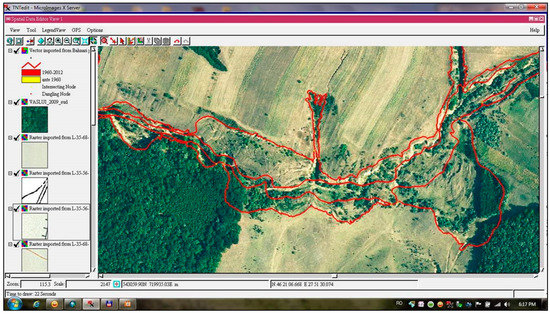
Figure 6.
The contour of the Puriceni-Bahnari gully system (the topographical survey carried out in April 2011 and April 2012 is superimposed over the aerial photos).
During the field trips, high-precision mapping of the entire gully and landslide system was conducted using a Global Positioning System (GPS) and Trimble total station with a Real-Time Kinematic (RTK) measurement system. The planimetry error ranged from 1 to 2 cm. Furthermore, the obtained database was processed using GIS software: TNT Mips 6.9 si 7.3, ARC Map 10, AutoCAD, and Global Mapper. Subsequently, the data collected in the field were compared with the data obtained both from the topographical maps and aerial photos. In addition, using the Universal Soil Loss Equation (USLE) [42,43] and Revised Universal Soil Loss Equation (RUSLE) [44,45], a map for the mean annual soil loss on agricultural land was achieved.
In the “Romanian” version of USLE [27], the equation is presented in the form:
where:
E = multiannual average erosion (t·ha−1)
K = erosion coefficient established on rain aggressiveness
S = erodibility coefficient
C = coefficient that expresses the influence of crops on soil erosion
Cs = coefficient for the influence of soil conservation measures
L = slope length (m)
i = slope value (%).
Lxi parameters were calculated according to Mitasova et al. (1996) and Desmet and Govers (1996) [46,47], while the values of the other parameters are those presented by Motoc for the MP [27,48]. The values for the coefficients were established and validated based on experimental runoff plots within the research stations in the network coordinated by C.C.D.C.E.S. Perieni starting 1970 [6,23,25,28,29,48].
Based on rain aggressiveness, Motoc established the spatial zoning of the climate aggression coefficient for entire Romania. Thus, the calculated value of K coefficient corresponding to central part of MP is 0.100.
The S coefficient takes into account the physical properties and erosion status as follows: 1.2 for excessively eroded and unstructured soils, 1.0 for very intensely eroded and poorly structured soils, 0.8 for intensely eroded soil having low cohesion, 0.7 for moderately eroded soils with moderately cohesion and well-developed profile and 0.6 for poorly eroded soils having high cohesion and well-developed profile. Further, the results obtained using the experimental plots showed that the values for C coefficient varies from a maximum of 1.0 for corn and sunflower and goes down to 0.7 for vineyards, 0.30 for peas and beans, 0.20 for spring cereals, 0.14 for winter cereals, 0.06 for perennial grassland in the first year, and 0.01 for perennial grassland starting from the second year. As regards the Cs coefficient, the values are as follows: 1.0 for crops in the up-and-down slope farming), 0.30–0.45 under strip-cropping, and 0.6–0.9 under contour cropping, both depending on the slope classes. The lowest value characterises the bench terraces (0.15).
Among all these coefficients, the most problematic is the one related to the rain aggressiveness that should be updated in the conditions of the current climate changes. For establishing the proper value of coefficients concerning the soil cover (S, C, and Cs), we used both updated pedological maps carried out by the County Office of Pedological and Agrochemical Studies Vaslui [39] and a detailed present land-use map achieved in scale 1:5000 (Figure 4). The data including the soil erosion intensity were validated by observations obtained directly from the field.
Finally, starting from the current land use pattern and the intensity of land degradation through erosion processes, a map of the conservation practices within the studied catchment was produced. This is considered as the optimal solution regarding the sustainable exploitation of soil-land resources in the studied area.
4. Results and Discussion
4.1. Land Degradation
The high intensity of land degradation in the studied area was mainly caused by the widespread erosion processes, including soil erosion, gully erosion, and landslides.
4.1.1. Soil Erosion
In accordance with the natural conditions specific to the Romanian territory, the agricultural land located on slopes higher than 5% is the most exposed areas to soil erosion [48]. According to the soil map, the extensive areas of the Puriceni-Bahnari catchment present favourable conditions for the development of this process. Out of the 874.34 ha of the Puriceni-Bahnari catchment, only 116.5 ha has a slope value of less than 5%, representing 13.32% of the total. The other 757.9 ha is located on slopes of over 5% that is theoretically prone to soil erosion. Of these, 536.3 ha has an agricultural use (arable, vineyard, and pasture). Effectively, out of the 632 ha with this use, 15.2% is on slopes with values <5% (96.4 ha), and 74.6% is on slopes from 5 to 18% (471.9 ha). Another 64.5 ha of agricultural land (10.2%) is located on slopes of over 18%. Consequently, a detailed analysis is required to correctly establish a proper land use pattern.
Although the values of “admissible” erosion on agricultural land in Romania range from 2–8 t·ha−1·yr−1, we opted for a limiting value of 7 t·ha−1·yr−1 [48] in accordance with the specific conditions of the southern part of the MP. Under the current land-use pattern, only 172.4 ha (27.3% of the total) of agricultural land has less of 7 t·ha−1·yr−1 (Figure 7), according to the map of the mean annual soil losses caused by soil erosion. Above this value (460 ha, 72.7%), the land must be used by considering soil erosion control measures.
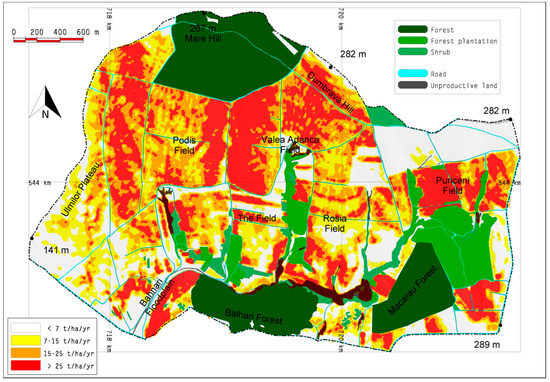
Figure 7.
Map of the mean annual soil losses on agricultural land in the Puriceni-Bahnari catchment.
At the catchment level, the mean value of annual soil loss on the agricultural land due to soil erosion amounted to 15.46 t·ha−1·yr−1 (13,500 t·yr-1).
The long-term studies carried out at the C.C.D.C.E.S. Perieni were based on measurements developed from 1970 to 1999 on runoff plots that were on a slightly eroded cambic chernozem and showed that the mean soil losses were 32.5 t·ha−1·yr−1 under fallow land and 7.7 t·ha−1·yr−1 under corn [6]. Given that the predominant soil in the Puriceni-Bahnari catchment is forest soil (Entic and Typic Luvosols) that is heavily eroded and therefore has almost double the value of the erodibility coefficient, it can be estimated that the calculated mean value of the soil losses is close to that in reality.
In any case, our current field observations and measurements validate the high intensity of soil erosion indicated by the equation of soil losses within the case study area, and they recommend the necessity for urgent application of soil erosion control measures.
4.1.2. Gully Erosion
Although gully erosion does not represent the most important geomorphological process of the region, the volume of eroded material can be the largest manifestation of this process in the whole plateau [49].
By using the data collected from the field, the gully erosion in the Puriceni-Bahnari catchment was drawn up. Thus, the presence of the two main gully types that are specific to the Barlad Plateau can be noticed, namely, continuous gullies on the valley bottom [50] and discontinuous gullies on the valley side [51] (Figure 8).
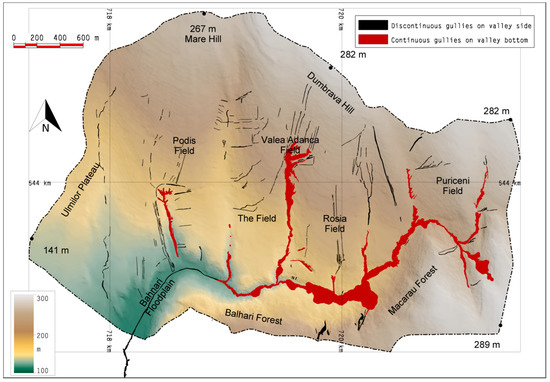
Figure 8.
Gully erosion map in the Puriceni-Bahnari catchment.
As can be seen in Table 2, over 8.46 ha of land is occupied by small discontinuous gullies, while the area occupied by continuous gullies exceeds 18.14 ha.

Table 2.
Area affected by gullies and landslides from 1956 to 2012.
Based on the detailed monitoring of 22 representative gullies within the Falciu Hills (including Puriceni 1 and Puriceni 2 gully heads), a strong linearity has been estimated between the mean annual retreat of gully head and mean annual eroded volume by gullying between 1956 and 2012 [49]. Only for Puriceni trunk gully (Puriceni 1), the calculated mean gully head retreat is 13.6 m·yr−1 over 180 year period. Furthermore, using the relation: Y = 282.16X − 422.61 (n = 22, R2 = 0.91, where X = mean gully head retreat and Y = mean eroded volume), the sediment yield by gulling in the entire Puriceni catchment is 9824 t·yr−1 (6775 m3·yr−1). An average bulk density of 1.45 t·m−3 was used to convert soil volumes to soil mass eroded (sediment yield) from gullies [6,24].
At the same time, during this 56 year period, the whole system went from a predominance of discontinuous gullies to continuous gullies, both on the slopes and valley bottom. The process is constantly evolving. The main evidence is proved by the identification of the following different stages of evolution:
- -
- Stage 1: represented by incipient small discontinuous gullies, as in gullies situated in the field area;
- -
- Stage 2: discontinuous evolved gullies, as in gullies in the area of the main peak (Puriceni Field);
- -
- Stage 3: continuous valley-side gullies that have “embedded” old discontinuous gullies, as in the gullies in the Valea Adanca Field;
- -
- Stage 4: continuous evolved gullies on valley bottoms developed on the main valley, as in the Puriceni catchment.
Usually, most of continuous gullies are accompanied and fed by upper discontinuous gullies that developed upstream from the main gully headcut. These discontinuous gullies have an important role in water concentration and gully incision on the valley bottom by governing runoff patterns towards and through the continuous gully heads and, implicitly, their growth [51].
In any case, through their specific spatial features (e.g., area, volume, retreat rate), the gullies within the studied area represent a genuine geomorphological trademark, giving specificity to the whole natural landscape of southern MP.
4.1.3. Landslides
In the central-southern part of the MP, landslides occupy relatively small areas compared to those in the northern areas (e.g., the Jijia Hilly Plain). This is due to the predominance of sandy deposits in the substratum. Instead, they have large amplitude.
In the studied area, the main cause of the appearance of these huge landslides is exclusively related to the occurrence of gullies (Figure 9). This is due to the collapse of the base of the slopes as a result of the incision produced by the advance of continuous gullies.

Figure 9.
Landslide caused by the extension of Valea Adanca gully, right tributary of the Puriceni-Bahnari Valley (March 2012).
Consequently, by adding the areas with gullies (18.14 ha) to the land affected by landslides (10 ha), a total area of over 36 ha of degraded land was obtained. Of these, 30.14 ha appeared from 1956 to 2012, resulting in a mean annual value of 0.54 ha of land removed from farming practice (Figure 10).
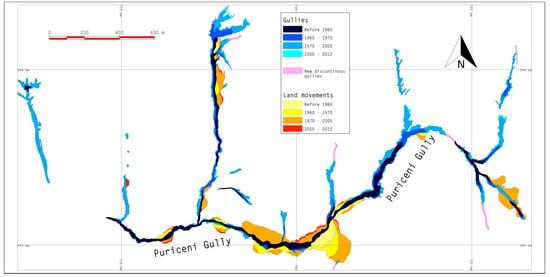
Figure 10.
Evolution of the Puriceni-Bahnari gully system from 1960 to 2012 [49].
Moreover, the high intensity of land degradation through erosion within this case study area is also proven by results concerning the assessment of the sedimentation rate on the alluvial plain within the Chioara-Ghermanesti catchment [49]. Thus, based on the application of the cesium Cs-137 technique, the results show a high sedimentation rate of about 1.67 cm·yr−1 in the period from 1986 to 2010 and 2.83 cm·yr−1 from 1963 to 1986, resulting in a mean value of 2.23 cm·yr−1 for a period of 47 years. These findings are related to a small contribution area of around 150 ha, but the consistent depth of this sediment blanket is directly related to the high quantity of sediments delivered by Puriceni 2 gully head, situated upstream. If we consider that this mean value is the same for the entire sediment blanket of approximately 340 cm, it can be stated that the sedimentation process started 150 years ago and was probably related to the Agrarian Reform of 1864.
4.2. Evolution of Soil Conservation Measures
Over the last two centuries in the studied area, the widespread expansion of agricultural land was made to the detriment of forested areas. Thus, at the beginning of the 19th century, the forest occupied approximately 55–60% ([49]), and in 1893, the surface was reduced to 31%. Nowadays, the forest comprises only 16%. Under these conditions, the erosion processes became widespread on the background of erodible forest soils. From 1950 to 1960, the land degradation reached the highest intensity all over the MP. After 1960, the first steps were taken to combat the effects of this process, including, in our case study, catchment (Figure 11).
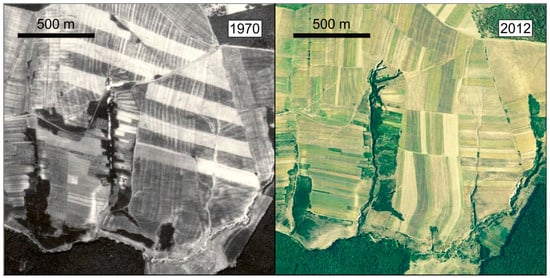
Figure 11.
Land-use pattern in the Puriceni-Bahnari catchment in 1970 and 2012 (aerial photo, 1970 and 2012).
Unfortunately, very few of these soil conservation efforts are still active today (Figure 12). In fact, the only works that are partially still standing are the forest plantations made of acacia (Robinia pseudoaccacia) that have been completed during the communist period. Simultaneously, by implementing the provisions of the Land Reform Act No. 18/1991, the contour farming was replaced by up-and-down hill farming accompanied by accentuated land fragmentation into small plots with an ordinary area of 1–2 ha. Moreover, the quasi-generalized spread of weakly protective crops based mainly on corn and sunflower is back on screen.
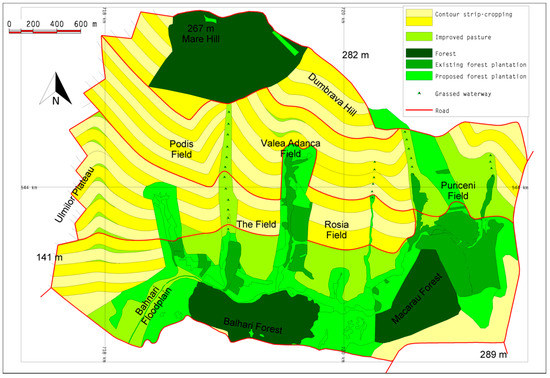
Figure 12.
Map of the conservation practices within the Puriceni-Bahnari catchment (Falciu Hills).
In this context, to conserve soil and water on agricultural land, the design and implementation of conservation practices on slopes are necessary.
The main proposed measures refer primarily to: (1) establishment of a rational (durable) land use pattern and (2) design of an optimal network of agricultural roads. To establish the correct land-use mode, a series of evaluation criteria were considered, such as geomorphological features (e.g., slope value and slope length and the existence of active geomorphological processes) or pedological features (e.g., the intensity of erosion, erodibility, and texture).
For example, on uniform slopes below 16–18% on which ploughing can be performed on the contour direction using wheeled tractors, it was decided to implement contour farming. On slopes over 16–18%, the optimal situation is represented by improved pastures and forest plantations that depend on the intensity of land degradation.
Overall, in our study area, the arable land must be reduced to about 418.7 ha (Figure 12 and Table 3).

Table 3.
Summary of the designing conservation practice in the Puriceni-Bahnari catchment.
Furthermore, a mixed erosion control system was adopted for the arable land that consisted of a combination of strip-cropping with bench terraces and used all three well-known structures, namely, a rectilinear structure, specific to rectilinear slopes; an amphitheatre-type structure, specific to concave slopes; and a spike structure for the convex type areas.
The criterion for permissible annual average erosion was used to calculate the strip width. Thus, we used the formulas established by [52] that were calculated according to the slope value (%) and specific erosion resistance of each type of soil:
- log. L = 2.22 − 0.03·i (for soils resistant to erosion);
- log. L = 2.15 − 0.03·i (for soils with a middle resistance to erosion);
- log. L = 2.05 − 0.03·i (for soils that slightly resist erosion).
where L = the width of the strip (m) and i = the value of slope (%).
As the soils are slightly resistant to erosion and the slopes have average values from 6–12%, the average strip width varies from 54 to 74 m. On the interfluvial ridges and at the slope base, where the soils are less eroded, the strip width varies from 82 to 96 m. The length of the 53 resulting strips varies from 850 to 1350 m, with an average area of 7.88 ha.
The pastures must reduce their area from 128.6 to only 97.7 ha. Due to the excessive degree of land degradation, the difference mainly falls into the category of forest plantations, resulting in seven new perimeters with an average area from 10 to 18 ha. Moreover, the urgent measures must be taken to improve the quality of these pastures.
If the meadows are in relatively good shape (e.g., with a reduced vegetation cover and reduced weight of weeds and anthills), it is possible to apply for ”light” surface measures [53]. For example, these measures should be applied to the pastures on the main floodplain near the road to Stoisesti. These measures consist of cleaning up plant debris, removing woody vegetation, controlling weeds, destroying anthills, clearing grasslands, improving the water regime, improving the food regime, introducing soil erosion control measures, and overseeding, for example. These technical-cultural measures aim at improving the living conditions of valuable plants in the meadows to cover the soil as completely as possible and improving the floristic composition without destroying the existing vegetation.
Since almost all the permanent meadows in the studied area are in an advanced stage of degradation with a predominantly vegetal carpet with a low nutritional value, they must be replaced by temporary meadows.
Moreover, we propose the application of a seed mixture to establish a temporary meadow for mixed use (grazing and mowing) on the background of a catchment with medium–low slope values (10–12%). The service life ranges from 4 to 6 years. Since the studied area is situated in a forest-steppe area, we opted for a mixture of grassy plants (60%), such as Poa pratensis and Festuca pratensis, and leguminous species (40%), such as Onobrychis viciifolia and Trifolium repens. The useful value of grass seeds must be 90% and that of legumes at least 80%.
Once the temporary grasslands are established, it is recommended that they be used exclusively as hayfield in the first year, although their proposed use is mixed. Temporary meadows located on slopes greater than 18–20% are recommended to be used only for mowing.
Another important issue is represented by the correct design of the road network. The following restrictions are considered: do not concentrate the liquid runoff and do not accentuate the erosion on the slopes, reduce distances and transport costs compared to the initial situation, allow easy access of the farm aggregates to each farming plot, and do not remove a land area of more than 2% from the farming circuit [1].
In this case, we propose two types of roads, namely, a serpentine-type road on the up-and-down hill direction and roads on in the hill contour direction. The roads situated on the interfluvial ridges become the main access roads, although they are apparently secondary. Due to the very long length of the slopes that range from 1600 to 2850 m, three new road sections are drawn longitudinally inside the main slope. One is drawn at the base of the slope, which favours easy access to newly proposed improved pastures.
Where the roads must be laid out on steep terrain, a network of serpentine-type roads in a spike-like shape is chosen. The length of the component road segments usually varies from 120 to 280 m, with only two sections of over 300 m drawn on steeper slopes.
All roads in the valley bottom should be excluded since they are difficult to maintain and also because of the complications related to the lateral undermining that they can cause.
Overall, the area occupied by the new road network reaches just over 9 ha (1.1%), less than half of the current situation.
In our proposed project, the forest represents the category with the biggest change. From about 24% today, forested areas should reach almost 40%. This is due to the 156 ha of proposed forest plantations (17.92% of the total) which complete the acacia plantations already implemented during the communist period (56 ha, 6.49%). All land on steep and very steep slopes is in a state of severe degradation, including currently unproductive land. In accordance with the ecology, the most suitable species are acacia (Robinia preudoaccacia), maple (Acer tataricum), honey locust (Gleditschia triacathos), sea buckthorn (Hippophae ramnoides), and hawthorn (Crataegus monogyna).
On unproductive land in advanced stages of degradation, the forest plantations are the only rational measure that can be established.
5. Conclusions
Land degradation through erosion processes is one of the most important issues regarding the sustainable agricultural use of land resources in contemporary Romania. The geomorphological processes that play the most important role in land quality degradation are represented by soil erosion and gully erosion and landslides to a lesser degree.
As a result of the socio-economic changes that occurred in Romanian society after 1990 along with an increase in the intensity of land degradation due to erosion, a sharp decline in the implementation of conservation practices occurred.
Consequently, the present paper aims to analyse the intensity of land degradation on the agricultural land in the Puriceni-Bahnari catchment area (Falciu Fills). Furthermore, the application of land conservation practices is the most suitable solution for the sustainable exploitation of this extremely important but fragile natural resource.
According to the map of the mean annual soil losses caused by the erosion, only 27.3% of the total 632.3 ha of agricultural land falls within the limit of admissible erosion of less 7 t·ha−1·yr−1. Consequently, all the other 460 ha (72.7%) must be used according to the soil erosion control measures.
As a solution to the existing land use pattern, we designed a map of proposed conservation measures on agricultural land for the whole catchment that can be relatively easy implemented and conserve soil and water on agricultural land.
The main issues of the proposed land-use pattern are: (1) the entire cropland must be changed to a strip-cropping system; (2) the quality of the pastures should be improved; (3) the forested area must be substantially extended, especially on account of unproductive land; and (4) the agricultural road network must be halved and entirely reshaped.
In conclusion, the large-scale implementation of conservation measures on agricultural land is the only rational solution for sustainable development of local communities in the hilly regions from eastern Romania. Such projects could be implemented only on the basis of the fulfilment of two specific preconditions, namely: (1) encouraging land merging and joint exploitation of the agricultural lands among landowners as a result of a sustained national policy in this direction and (2) establishing financial and technical support of the State. The local farmers understand the need for implementing such measures, but the economic condition does not allow them such substantial investments. All these states the urgent need for agriculture and rural areas to become a priority of national development policies in Romania.
Author Contributions
Author Contributions: conceptualization, L.N., D.B. and I.I.; methodology, I.I., D.B. and L.N.; software, L.N. and I.-C.C.; validation, L.N. and I.I.; formal analysis, L.N.; investigation, L.N., D.B., I.I. and I.-C.C.; resources, L.N. and D.B.; data curation, L.N.; writing—original draft preparation, L.N.; writing—review and editing, L.N. and D.B.; visualization, L.N.; supervision, D.B., I.I.; project administration, L.N.; funding acquisition, D.B. All authors have read and agreed to the published version of the manuscript.
Funding
This research was funded by Department of Geography, Faculty of Geography & Geology, “Alexandru Ioan Cuza” University of Iasi (Internal Research Program no. 1/2021) and by Romanian Ministry of Education through National Council for the Financing of Higher Education. Target area: 6. Development of institutional capacity for research in universities. Project title: Development and support of the research capacity of the University of Agricultural Sciences and Veterinary Medicine of Iasi (AGRIS). Code: CNFIS-FDI-2021-0076.
Institutional Review Board Statement
Not applicable.
Informed Consent Statement
Not applicable.
Acknowledgments
Acknowledgment is given by L.N. to the infrastructure support from the Operational Program Competitiveness 2014–2020, Axis 1, under POC/448/1/1 research infrastructure projects for public R&D institutions/Sections F 2018, through the Research Center with Integrated Techniques for Atmospheric Aerosol Investigation in Romania (RECENT AIR) project, under grant agreement MySMIS no. 127324.
Conflicts of Interest
The authors declare no conflict of interest. The funders had no role in the design of the study; in the collection, analyses, or interpretation of data; in the writing of the manuscript, or in the decision to publish the results.
References
- Savu, P.; Bucur, D. Agricultural Land Planning with Land Improvement Work; Ion Ionescu de la Brad University Publishing House: Iasi, Romania, 2002. [Google Scholar]
- Poesen, J. Soil erosion in the Anthropocene: Research needs. Earth Surf. Processes Landf. 2018, 43, 64–84. [Google Scholar] [CrossRef]
- Brown, L.R. Global Issues of Humanity; Technical Publishing House: Bucharest, Romania, 1988. [Google Scholar]
- Posthumus, H.; Deeks, L.K.; Rickson, R.J.; Quinton, J.N. Costs and benefits of erosion control measures in the UK. Soil Use Manag. 2015, 31, 16–33. [Google Scholar] [CrossRef]
- Bucur, D.; Jitareanu, G.; Ailincai, C.; Tsadilas, C.; Mercus, A. Influence of soil erosion on water, soil, humus and nutrient losses in different crop systems in the Moldavian Plateau, Romania. J. Food Agric. Environ. 2007, 5, 261–264. [Google Scholar]
- Ionita, I. Applied Geomorphology (Degradation Processes of Hilly Regions); Alexandru Ioan Cuza University of Iasi Publishing House: Iasi, Romania, 2000; p. 248. [Google Scholar]
- Guo, Y.; Peng, C.; Zhu, Q.; Wang, M.; Wang, H.; Peng, S.; He, H. Modelling the impacts of climate and land use changes on soil water erosion: Model applications, limitations and future challenges. J. Environ. Manag. 2019, 250, 109403. [Google Scholar] [CrossRef]
- Li, P.; Zang, Y.; Ma, D.; Yao, W.; Holden, J.; Irvine, B.; Zhao, G. Soil erosion rates assessed by RUSLE and PESERA for a Chinese Loess Plateau catchment under land-cover changes. Earth Surf. Process. Landf. 2020, 45, 707–722. [Google Scholar] [CrossRef]
- Wauters, E.; Bielders, C.; Poesen, J.; Govers, G.; Mathijs, E. Adoption of soil conservation practices in Belgium: An examination of the theory of planned behaviour in the agri-environmental domain. Land Use Policy 2010, 27, 86–94. [Google Scholar] [CrossRef]
- Lenka, N.K.; Rao, B.K. Erosion Management: Hill Soils. In Encyclopedia of Soil Science, 3rd ed.; Lal, R., Ed.; Springer Science & Business Media: Berlin/Heidelberg, Germany, 2017; Volumes I–III, pp. 746–752. [Google Scholar]
- Panagos, P.; Ballabio, C.; Himics, M.; Scarpa, S.; Matthews, F.; Bogonos, M.; Poesen, J.; Borrelli, P. Projections of soil loss by water erosion in Europe by 2050. Environ. Sci. Policy 2021, 124, 380–392. [Google Scholar] [CrossRef]
- Maetens, W.; Poesen, J.; Vanmaercke, M. How effective are soil conservation techniques in reducing plot runoff and soil loss in Europe and the Mediterranean? Earth-Sci. Rev. 2012, 115, 21–36. [Google Scholar] [CrossRef] [Green Version]
- Xiong, M.; Sun, R.; Chen, L. Effects of soil conservation techniques on water erosion control: A global analysis. Sci. Total Environ. 2018, 645, 753–760. [Google Scholar] [CrossRef]
- Li, J.; Liu, Q.; Feng, X. The synergistic effects of afforestation and the construction of check-dams on sediment trapping: Four decades of evolution on the Loess Plateau, China. Land Degrad. Dev. 2019, 30, 622–635. [Google Scholar] [CrossRef]
- Chen, J.; Xiao, H.; Li, Z.; Liu, C.; Ning, K.; Tang, C. How effective are soil and water conservation measures (SWCMs) in reducing soil and water losses in the red soil hilly region of China? A meta-analysis of field plot data. Sci. Total Environ. 2020, 735, 139517. [Google Scholar] [CrossRef]
- Niacsu, L.; Ionita, I.; Samoila, C.; Grigoras, G.; Blebea-Apostu, A.M. Land degradation and soil conservation measures in the Moldavian Plateau, eastern Romania: A case study from Racova Catchment. Water 2021, 13, 2877. [Google Scholar] [CrossRef]
- Xueyan, S.; Chen, L.; Shenglu, Z. Spatial Decision Analysis on Soil Erosion Control Measures Research Based on GIS: Taking Changting Country as an Example. In Proceedings of the 2012 Third World Congress on Software Engineering, Wuhan, China, 6–8 November 2012; IEEE Computer Society: Washington, DC, USA; pp. 119–122. [Google Scholar]
- Zhang, S.; Zhou, L. Assessment of Soil Erosion in Suihua City Based on RUSLE and GIS. In Proceedings of the 2011 International Conference on Computer Distributed Control and Intelligent Environmental Monitoring, Changsha, China, 19–20 February 2011; IEEE Computer Society: Washington, DC, USA; pp. 1979–1982. [Google Scholar]
- Ionita, I.; Radoane, M.; Mircea, S. 1.13 Romania. In Soil Erosion in Europe; Boardman, J., Poesen, J., Eds.; Publisher John Wiley: Chichester, UK, 2006; pp. 155–166. [Google Scholar]
- Radoane, M.; Ichim, I.; Radoane, N. Gully distribution and development in Moldavia. Romania. Catena 1995, 24, 127–146. [Google Scholar] [CrossRef]
- Margarint, M.C.; Niculita, M. Landslide Type and Pattern in Moldavian Plateau, NE Romania. In Landform Dynamics and Evolution in Romania; Book Series Springer Geography; Radoane, M., VespremeanuStroe, A., Eds.; Springer: Berlin/Heidelberg, Germany, 2017; pp. 271–304. [Google Scholar]
- Solutions for Anti-Erosion Organization of the Territory and for Sustainable Agricultural Exploitation Based on the Inventory of Landslides and Ravines in the Tomești River Basin, Vaslui County (Summary of the Technical-Scientific Report, 2021): “Mircea Moţoc” Perieni Soil Erosion Research-Development Station, Romania. Available online: http://www.cesperieni.ro (accessed on 5 December 2021). (In Romanian).
- Ionita, I.; Ouatu, O. Critical Erosion Season in Tutovei Hills; Scientific Annals of Alexandru Ioan Cuza University of Iasi: Iasi, Romania, 1990. (In Romanian) [Google Scholar]
- Ionita, I. Gully Formation and Evolution in the Barlad Plateau; Corson Publishing House: Iasi, Romania, 2000. [Google Scholar]
- Motoc, M.; Ionita, I. Riscul erozional la principalele culturi agricole in Podisul Moldovei. In Soil Erosion and Control Methods; Papers of the International Scientific Conference; The State Agrarian University of Moldova: Chisinau, Moldova, 1995. [Google Scholar]
- Pujina, D. Research concerning Landsliding Processes on Agricultural Lands in the Barlad Plateau and contributions to Land Conservation Techniques. Ph.D. Thesis, Gheorghe Asachi Technical University of Iasi, Iasi, Romania, 1997. [Google Scholar]
- Motoc, M.; Munteanu, S.; Baloiu, V.; Stanescu, P.; Mihaiu, G. Soil Erosion and Control Methods; Ceres Publishing House: Bucharest, Romania, 1975. [Google Scholar]
- Popa, A.; Stoian, G.; Popa, G.; Ouatu, O. Soil Erosion Control on Arable Lands; Ceres Publishing House: Bucharest, Romania, 1984. [Google Scholar]
- Popa, N. Contributions to the elaboration of models for forecasting soil losses and fertilizing elements on agricultural slopes, with reference to Barlad Plateau. Ph.D. Thesis, Gheorghe Asachi Technical University of Iasi, Iasi, Romania, 1999. [Google Scholar]
- Bacauanu, V.; Barbu, N.; Pantazica, M.; Ungureanu, A.L.; Chiriac, D. Moldavian Plateau. Nature, Man, Society; Scientific and Encyclopedic Publishing House: Bucharest, Romania, 1980. [Google Scholar]
- Ungureanu, A.L. Geography of the Romanian Plateaus and Plains; Alexandru Ioan Cuza University Publishing House: Iasi, Romania, 1993. [Google Scholar]
- Jeanrenand, P. Geology of central Moldova between Siret and Prut. Ph.D. Thesis, Alexandru Ioan Cuza University of Iasi, Iasi, Romania, 1971. [Google Scholar]
- Kottek, M.; Grieser, J.; Beck, C.; Rudolf, B.; Rubel, F. World map of the Köppen-Geiger climate classification updated. Meteorol Z. 2006, 15, 259–263. [Google Scholar] [CrossRef]
- Sandu, I.; Pescaru, V.I.; Poiana, I.; Geicu, A.; Candea, I.; Tastea, D. Climate of Romania; Academic Press: Cluj-Napoca, Romania, 2008; p. 365. [Google Scholar]
- Rusu, C. (Ed.) The Hidro-Climatic and Pedo-Geomorphologic Impact on the Environment within Barlad Catchment; Performantica Publishing House: Iasi, Romania, 2008. [Google Scholar]
- Romanian Geography; Romanian Academy Publishing House: Iasi, Romania, 1983; Volume I.
- Pedological Study of Banca Territory. Includes Soils Map of Banca Territory-Scale 1:10,000; Office for Pedological and Agrochemical Surveys: Vaslui, Romania, 1997; p. 88.
- Ministry of Regional Development and Public Administration. Territorial Observatory. Available online: https://ot.mdrap.ro/arcgis/home/ (accessed on 10 January 2022).
- Bojoi, I. The Geographic Landscape Dinamics within Barlad Plateau–Research Grant No. 5011/254/1996; Faculty of Geography and Geology, Alexandru Ioan Cuza University of Iasi: Iasi, Romania, 1996. [Google Scholar]
- Stanga, I.C.; Niacsu, L. Using old maps and soil properties to reconstruct the forest spatial pattern in the late 18th century. Environ. Eng. Manag. J. 2016, 15, 1369–1378. [Google Scholar]
- National Agency for Cadastre and Land Registration (NACLR) (in Romanian).Topographic Map, Scale 1:5,000, Stereo 70 Projection and Aerial Photos in Scale 1:5,000, Bucharest, 1974, 1977, 1981, 1983. Available online: https://www.ancpi.ro/ (accessed on 11 November 2021).
- Wischmeier, W.H.; Smith, D.D. A Universal Soil-Loss Equation to guide conservation farm planning. Trans. Int. Congr. Soil Sci. 1960, 1, 418–425. [Google Scholar]
- Wischmeier, W.H.; Smith, D.D. Predicting Rainfall Erosion Losses, a Guide to Conservation Planning; USDA Agriculture Handbook, No. 537; USDA: Washington, DC, USA, 1978.
- Renard, K.G.; Foster, G.R.; Yoder, D.C.; McCool, D.K. RUSLE revisited: Status, questions, answers, and the future. J. Soil Water Conserv. 1994, 49, 213–220. [Google Scholar]
- Renard, K.G.; Foster, G.R.; Weesies, G.A.; McCool, D.K.; Yoder, D.C. Predicting Soil Erosion by Water: A Guide to Conservation Planning with the Revised Universal Soil Loss Equation (RUSLE); Agriculture Handbook; US Department of Agriculture: Washington, DC, USA, 1997; Volume 703, p. 384. [Google Scholar]
- Mitasova, H.; Hofierka, J.; Zlocha, M.; Iverson, L.R. Modelling topographic potential for erosion and deposition using GIS. Int. J. Geogr. Inf. Syst. 1996, 10, 629–641. [Google Scholar] [CrossRef]
- Desmet, J.J.; Govers, G. A GIS procedure for automatically calculating the USLE LS factor on topographically complex landscape units. J. Soil Water Conserv. 1996, 51, 427–433. [Google Scholar]
- Motoc, M. Average Rate of Soil Erosional Degradation in R.S. Romania; Buletin Informativ ASAS: Bucharest, Romania, 1983; Volume 2, pp. 67–73. [Google Scholar]
- Ionita, I.; Niacsu, L.; Petrovici, G.; Blebea-Apostu, A.M. Gully development in eastern Romania: A case study from Falciu Hills. Nat. Hazards 2015, 79 (Suppl. S1), 113–138. [Google Scholar] [CrossRef]
- Ionita, I.; Niacsu, L.; Poesen, J.; Fullen, M.A. Controls on the development of continuous gullies: A 60 year monitoring study in the Moldavian Plateau of Romania. Earth Surf. Process Landf. 2021, 46, 2746–2763. [Google Scholar] [CrossRef]
- Ionita, I.; Niacsu, L.; Poesen, J.; Fullen, M.A. Medium-term development of discontinuous gullies. Geomorphology 2022, 398, 108024. [Google Scholar] [CrossRef]
- Stanescu, P. Estimation of Potential Erosion on Agricultural Land. Ph.D. Thesis, University of Agronomic Sciences and Veterinary Medicine of Bucharest, Bucharest, Romania, 1979. [Google Scholar]
- Dumitrescu, N.; Iacob, T.; Vintu, V.; Samuil, C. Improvement of Degraded Grasslands in the Forest-Steppe Area; Ion Ionescu de la Brad Publishing House: Iasi, Romania, 1999; p. 374. [Google Scholar]
Publisher’s Note: MDPI stays neutral with regard to jurisdictional claims in published maps and institutional affiliations. |
© 2022 by the authors. Licensee MDPI, Basel, Switzerland. This article is an open access article distributed under the terms and conditions of the Creative Commons Attribution (CC BY) license (https://creativecommons.org/licenses/by/4.0/).